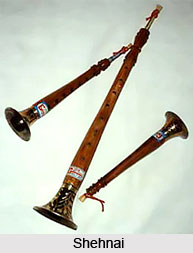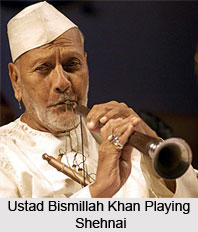 Shehnai is the predominant double-reed instrument used in North Indian music. The size of the Shehnai ranges from one to one and a half feet. Whether the instrument Shehnai was imported into India from Central or West Asia is not certain; the word certainly was. Other instruments related to this one are the Sundri and Naferi which are small sized oboes.
Shehnai is the predominant double-reed instrument used in North Indian music. The size of the Shehnai ranges from one to one and a half feet. Whether the instrument Shehnai was imported into India from Central or West Asia is not certain; the word certainly was. Other instruments related to this one are the Sundri and Naferi which are small sized oboes.
Origin of Shehnai
The Shehnai, a traditional Indian woodwind instrument renowned for its melodic resonance, is believed to have evolved through refinements made to the pungi, an ancient folk instrument primarily used in snake charming performances.
An alternate hypothesis surrounding the genesis of the Shehnai suggests that its nomenclature originates from the term "shah-nai," wherein "nai" signifies a barber in various Indian languages, and "shah" denotes royalty. This nomenclature is rooted in the historical context of the instrument`s debut within the chambers of royalty, played by a nai or barber. Consequently, the name "shehnai" was assigned to the instrument. The distinctive auditory qualities of the Shehnai`s tones gradually became associated with auspiciousness, leading to its enduring presence in temples and its integral role in Indian weddings. For an extensive period, its utility remained confined to sacred settings like temples and matrimonial ceremonies. The eminent Ustad Bismillah Khan is credited with elevating the Shehnai`s status to the classical stage.
Diverse regional adaptations of the Shehnai are discernible across Western India and Coastal Karnataka, each reflecting the local cultural milieu. Particularly, the Shehnai`s presence is deeply entrenched in the Goan/ Konkani region, where practitioners known as "Vajantri" have been closely associated with the region`s temples and the Western coastal expanse. The historical connection between these players and the temples has led to the allocation of lands as recognition for their contributions to temple services.
History of Shehnai
The instrument of the Shehnai (or Surnai) is believed to have been introduced in India by the Muslims. One of its most prominent uses was in the ensemble called the naubat (or nahabet), which played at the courts of the Mughal Emperors. The naubat consisted of a varying number of specific instruments - kettledrums of various sizes, other types of drums, trumpets, horns, cymbals, and Shehnais with their accompanying drones. This naubat disseminated the status of the Shehnai, which came to be regarded an indispensable part of every celebrations of every religion. Slowly, it began to be during pujas. The Shehnai came to be associated with the temple and thereby came to be called a `mangal vadya` or an auspicious instrument. While a person belonging to the priestly class blew the Shankh, or the conch, during sacred rituals inside the worship area, Shehnai players, who belonged to the lower caste, played the reed instrument from outside the worship area. No social ceremony such as engagement, marriage, childbirth and the investiture of the sacred thread was complete without the soothing strains of the Shehnai. Again, the Shehnai players had to play their instrument from outside the precincts of the house for reasons related to caste. It was not until the beginning of the 20th century that this instrument was granted the status of a classical instrument
Construction of Shehnai
It is made completely of wood except for the metal bell at its enlarged lower end. The bore is conical. The basically functional parts are two: the reed and the tube. There are two small reeds held together, leaving small gap between them. The reeds are fixed to the tube of the instrument, either directly or by means of a metallic staple. The main body of the instrument is the tube which is the resonator. It is conical in shape, narrow near the blowing end and opening out gradually. Usually, there is metallic `bell` at the farther end. The tube is usually of wood, but may be of metal also. It has a total of seven playing holes and one or two more for adjusting the pitch. The double reed is attached to a narrow stem that rises out of the top of the instrument. Like the Nadasvaram, one plays the Shehnai by controlling the flow of air through the column (though with a different technique), and obtains desired pitches by partially or completely covering the holes. The accompanying drone (sruti or sur) is provided by a fellow reed instrument, which looks like the Shehnai but has only two or three holes. These are stopped wholly or partially with wax so that the player can tune the drone to the desired pitch.
Playing of Shehnai
As with flute, all musical notes are produced by the controlled flow of breath through the reed into the tube area. Agile finger-work is required to execute the movements, graces and ornaments of classical music. The production of musical notes is wholly dependent on the manipulation of the fingering technique - i.e., the full closure or partial closure of the blow holes. Alongside the various positioning of the jaw, the tongue and the lips also help in the production of various musical movements and graces. A seasoned player uses a combination of lip and tongue-work along with dexterous fingering during recitals. The drone during the concert is provided by a pipe, called the Sur, whose seven blow holes are blocked-up with wax, is used to provide the continuous drone. A small earthen kettle drum, called Duggad, provides the rhythmic accompaniment. However, these days it is not uncommon for the Shehnai player to use the Tabla alongside the Duggad. Varanasi is to this day the leading producer of some of the finest Shehnais in the country.
 Players of Shehnai
Players of Shehnai
The contributions made by players such as Chhote Khan, Gaurishankar and Nandlal, who was Chhote Khan`s disciple, belonging to Benaras, to elevate the Shehnai to the level of a concert instrument has been immense. In fact, more than any other city, it is Benaras that has come to be associated with the instrument and still continues to produce some of the finest players on the country. More than anyone, it is Ustad Bismillah Khan who was solely responsible for popularising the Shehnai as a concert instrument both nationally and internationally.




















